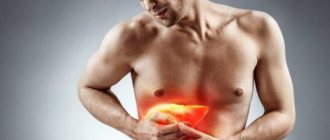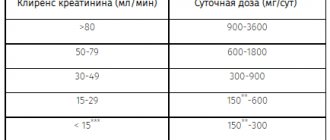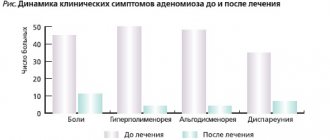The liver is the second organ after the brain that does not have nerve endings, and therefore does not generate pain in our body. Why then do we say: “My liver hurts or aches.” Similar sensations that occur in the right hypochondrium occur when the liver becomes inflamed or exposed to various kinds of diseases. Increasing in size or deforming, the capsule stretches, and the liver begins to put pressure on adjacent organs and tissues, causing discomfort. Even the slightest discomfort in this area, which lasts more than one or two days, is a reason to pay close attention to the gland and get help.
In this article we talk about Essentiale, a drug for the treatment and prevention of liver diseases. When, how and why to use it, when the effect occurs.
Composition and mechanism of action
The drug is available in two forms:
- Essentiale injection solution in ampoules containing 250 mg of active substance per 5 ml;
- Essentiale capsules 300 mg - sold with the Forte prefix. Auxiliary components make the contents of the capsules similar in structure to honey.
The active ingredient is a complex of essential phospholipids, which are obtained from soybeans. They are similar to endogenous phospholipids, but contain more polyunsaturated fatty acids. Their cis-double bonds prevent carbohydrate chains from being placed in parallel, accelerating the excretion and intake of substances. The molecules of the substance are integrated into cell membranes, activating the hepatoprotective function.
As a result of exposure to phospholipids, cholesterol is transformed into forms that are suitable for excretion by attaching to HDL.
During the removal of phospholipids from the body through the bile ducts, the lithogenic index decreases and the bile content stabilizes.
90% of Essentiale tablets are absorbed in the tissues of the small intestine, a small part breaks down under the influence of phospholipase to acyl-lysophosphatidylcholine.
The maximum level of phosphatidylcholine in the body will be reached 7-24 hours after administration.
Essentiale forte N caps 300 mg N30 (Sanofi)
Essentiale N is a hepatoprotector. Pharmacodynamics Essential phospholipids are the main elements of the structure of the cell membrane and cellular organelles. In liver diseases, there is always damage to the membranes of liver cells and their organelles, which leads to disturbances in the activity of enzymes and receptor systems associated with them, deterioration in the functional activity of liver cells and a decrease in the ability to regenerate. The phospholipids included in the drug Essentiale Forte N correspond in their chemical structure of endogenous phospholipids, but are superior to endogenous phospholipids in activity due to their higher content of PUFAs (essential fatty acids). The integration of these high-energy molecules into damaged areas of hepatocyte cell membranes restores the integrity of liver cells and promotes their regeneration. Cis-double bonds from PUFAs prevent the parallel arrangement of hydrocarbon chains in the phospholipids of cell membranes; the phospholipid structure of the cell membranes of hepatocytes is “loosened,” which increases their fluidity and elasticity, improves metabolism. The resulting functional blocks increase the activity of enzymes fixed on membranes and promote normal physiological pathways of the most important metabolic processes. Phospholipids, which are part of the drug Essentiale forte N, regulate the metabolism of lipoproteins, transferring neutral fats and cholesterol to sites of oxidation, mainly by increasing the ability of HDL to bind to cholesterol. Thus, there is a normalizing effect on metabolism lipids and proteins; on the detoxification function of the liver; to restore and preserve the cellular structure of the liver and phospholipid-dependent enzyme systems, which ultimately prevents the formation of connective tissue in the liver and promotes the natural restoration of liver cells. With the excretion of phospholipids into the bile, the lithogenic index decreases and the bile is stabilized. Pharmacokinetics More than 90% of phospholipids taken orally are absorbed into small intestine. Most of them are cleaved by phospholipase A to 1-acyl-lysophosphatidylcholine, 50% of which is immediately reverse acetylated into polyunsaturated phosphatidylcholine during the absorption process in the intestinal mucosa. This polyunsaturated phosphatidylcholine enters the bloodstream through the lymph and from there, mainly bound to HDL, enters the liver. Pharmacokinetic studies in humans were carried out using dilinoleyl-phosphatidylcholine with a radioactive label (3H and 14C). The choline part was labeled with 3H, and the linoleic acid residue was labeled with 14C. Cmax 3H is achieved 6–24 hours after administration and is 19.9% of the prescribed dose. T1/2 of the choline component is 66 hours. Cmax 14C is achieved 4–12 hours after administration and is up to 27.9% of the prescribed dose. T1/2 of this component is 32 hours. In feces, 2% of the administered dose of 3H and 4.5% of the administered dose of 14C are found, in urine - 6% of 3H and only a minimal amount of 14C. Both isotopes are more than 90% absorbed into intestines.
Dosages
The initial dose of the drug is 2 capsules three times a day, and during maintenance therapy - 1 capsule three times a day. Capsules should be taken with meals, without chewing, and with 50–100 milliliters of water. The duration of treatment should be at least 3 months.
Essentiale solution in injections is prescribed intravenously to adults and adolescents at a dose of 5–10 milliliters per day. The dose can be increased to 10–20 milliliters per day. Infusion is usually used for up to 10 days. Parenteral treatment is recommended to be supplemented with capsules. The course of treatment with the drug is 3–6 months.
Essentiale for psoriasis is prescribed 2 capsules three times a day for two weeks, after which 10 injections of 5 ml each should be given with the parallel use of PUVA therapy. After a course of injections, taking capsules is resumed and continues for 60 days.
Side effects of Essentiale® Forte N
Essentiale® Forte N has a favorable safety profile and is usually well tolerated. To reduce the risk of side effects, it is important to know about the contraindications to the use of Essentiale® Forte N and follow the required dosage: take two capsules three times a day with meals (they should be swallowed whole and washed down with a whole glass of water)4.
The following side effects are possible when taking Essentiale® Forte N:
- stomach discomfort;
- soft stools or diarrhea;
- allergic reaction in the form of itching, rash, urticaria4.
If you are taking any other medications besides Essentiale® Forte N, be sure to tell your doctor about this. The fact is that you must always take into account the compatibility of drugs with each other. Thus, it is known about the potential interaction of Essentiale Forte N with drugs that affect blood clotting (anticoagulants). In this case, dose adjustment of anticoagulants may be necessary4.
Contraindications, side effects and features of use
Contraindications include individual intolerance to the components of the drug. Side effects are rare, but at high dosages, disturbances in the gastrointestinal tract, including diarrhea, are possible.
In rare cases, rash, itching and increased sensitivity may occur.
- If there are allergic reactions to soy products, the drug should not be used.
- Due to the lack of research on the use of Essentiale during pregnancy and lactation, it is not used.
- The drug is prescribed to children over 12 years of age and weighing more than 43 kilograms.
- No effect on psychomotor functions was detected.
The solution for injection should not be diluted in electrolytes.
Special Recommendations
Essentiale and alcohol
Since alcohol has a well-known toxic effect on the body and liver cells, the use of Essentiale and alcohol intake become incompatible concepts. In addition, one should not assume that the drug is capable of providing a supportive and protective effect on the liver while taking alcohol-containing products. During treatment with Essentiale, it is recommended to refrain from drinking alcohol.
Essentiale and diet
Compliance with a strictly mandatory diet during the course of Essentiale is not a strict obligation, but only a recommendation. Any disease of the digestive organs and glands requires dietary nutrition. Because diet is the basis for a positive outcome in such diseases. During the acute period of the disease, the liver is especially vulnerable and it needs support “on all fronts.” So, you should maximally exclude from the diet foods that load the liver and disrupt the motility of the biliary tract: fatty and fried foods, exclude smoked and pickled foods, any dough and fresh baked goods, baked goods (for example, dried bread, crackers and biscuits in reasonable quantities), strong, rich soups with mushroom, fish or meat broths, offal, foods cooked on the grill or fire, canned food, legumes, spices.
Essentiale during pregnancy
The drug Essentiale is recommended during pregnancy as a means of relieving toxicosis and nausea syndromes. However, during this period it should be taken strictly on the recommendation of a specialist, excluding potential risks for both the fetus and the expectant mother. But during breastfeeding, this drug is contraindicated, since research in this area has not been conducted.
Popular questions about Essentiale
How to drink Essentiale?
For the prevention of liver diseases and intoxications, take 1 capsule three times a day for 3 months. For treatment, the dose is doubled. Capsules are taken during meals with 50–100 milliliters of water.
How to give Essentiale to a baby?
The drug is not prescribed to newborn children.
What does Essentiale Forte help with?
Essentiale Forte helps restore damaged liver cells, improves bile excretion, and reduces cholesterol levels.
What is Essentiale Forte?
Essentiale Forte is a set of essential phospholipids that has hepatoprotective and regenerating effects on liver structures.
Liver diseases
The liver is a very powerful and the only filter of our body. Nature made sure that this filter is capable of self-healing, because it carries vital functions:
- Protective, or detoxifying, function of the liver. Some substances, such as barbiturates or alcohol, are completely destroyed in the liver. However, taking large doses of sleeping pills leads to damage to liver cells.
- Removing harmful substances from the body.
- Urea is formed in liver cells from ammonia. Urea from the liver travels through the bloodstream to the kidneys, from where it is excreted in the urine.
- Formation and production of bile. Bile promotes the absorption of fats in the small intestine and the neutralization of hydrochloric acid.
- The liver plays an important role in maintaining a constant blood composition.
- Accumulation of nutrients, vitamins and iron.
The liver clears the blood of bilirubin, the remnants of red blood cells that have outlived their 110-day life. The gland is most active from 1 to 3 am. The fact that she is not all right is indicated by such symptoms as: dry throat, bitterness in the mouth, pain in the right hypochondrium, inability to bend over, heaviness, dull or aching sensations, increased bloating, constant nausea, vomiting, lightening of the stool, change in its consistency, darkening of urine, change in skin color (yellowishness of the skin and sclera), the appearance of “red spider veins,” weight loss, enlargement of internal organs, determined by palpation.
Causes of liver disease
Viruses and bacteria. Viral diseases include hepatitis types A, B, C, D and others. They provoke acute and chronic inflammatory processes. In 57% of cases, hepatitis develops into cirrhosis of the liver. The causes of bacterial infections are usually echinococcus, alveococcus and roundworms, as well as leptospira - the causative agents of leptospirosis. The diseases also occur in acute or chronic form and in the form of cystic transformation of the liver.
Violation of fat metabolism. In this case, the content of lipids (fats) in the liver cells increases, which is why the iron may increase in size and lose its ability to function normally. This leads to the development of diseases such as fatty hepatosis (steatosis of the liver) and subsequently to cirrhosis. Disorders of fat metabolism in the liver in Russia affect about 27% of the population.
Alcohol abuse. Systematic excessive consumption of alcoholic beverages has a detrimental effect on liver cells, which over time can cause cirrhosis. Researchers have derived a relatively safe daily dose of ethanol-containing drinks: less than 30 ml of vodka (cognac, whiskey), 150 ml of wine or 250 ml of beer per day for women and 60 ml of vodka (cognac, whiskey), 300 ml of wine or 500 ml of beer per day - for men.
Toxic damage from drugs. Occurs as a result of uncontrolled use of medications, which leads to changes in liver tissue and disruption of its normal functioning. There are acute and chronic forms of toxic lesions. Chronic diseases arise due to the constant ingestion of doses of toxic substances into the body. They can be asymptomatic for years.
When metabolic processes in the liver and gallbladder are disrupted, stones can form. These gallstones do not cause any discomfort for the time being. But one day the disease may manifest itself in the form of “biliary colic,” when severe pain occurs due to a stone getting stuck in the bile duct. This condition can be life-threatening.
Note!
The description of the drug Essentiale on this page is a simplified author’s version of the apteka911 website, created on the basis of the instructions for use.
Before purchasing or using the drug, you should consult your doctor and read the manufacturer's original instructions (attached to each package of the drug). Information about the drug is provided for informational purposes only and should not be used as a guide to self-medication. Only a doctor can decide to prescribe the drug, as well as determine the dose and methods of its use.



